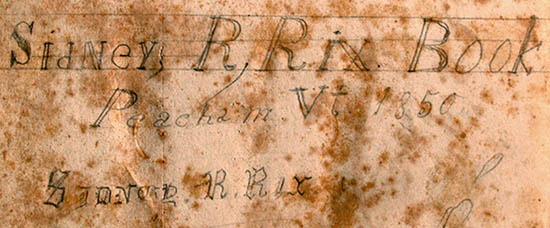Sidney Rix's Algebra Book
Today, Sidney Rix's new algebra book. The University of Houston's College of Engineering presents this series about the machines that make our civilization run, and the people whose ingenuity created them.
Here's a typical problem from Davies' 1850 algebra textbook:
A $7500 estate is to be divided among a widow, two sons, and three daughters. Each son is to receive twice as much as each daughter, and the widow $500 more than all the children. Determine the share of each.
 That's meant for practice in setting up first degree algebraic equations; but it tells as much about family structure, a century and a half ago, as it does about algebra. This book is signed three times by 20-year-old Sidney Rix. One's a flashy cursive signature. One's penciled, very ornately, the way a sign painter would lay out text. And he's penciled his name in a fancy Gothic font.
That's meant for practice in setting up first degree algebraic equations; but it tells as much about family structure, a century and a half ago, as it does about algebra. This book is signed three times by 20-year-old Sidney Rix. One's a flashy cursive signature. One's penciled, very ornately, the way a sign painter would lay out text. And he's penciled his name in a fancy Gothic font.
Sidney Rix also writes Peacham, Vermont, below his name, and here things get interesting. A year after he signed his book, one Alfred Rix married Chastina Walbridge, in Peacham. Sidney turns out to've been the son of Alfred Rix's cousin.
The first of Alfred and Chastina's two children, Julian, was born eighteen months later. When Julian was three, they moved to California, which was booming after the Gold Rush. Our book-signer Sidney died young in 1854; and (out in California) Chastina died in '57. Julian went back to live with his grandmother in Peacham; and, after he finished school at the Peacham Academy, he returned to San Francisco to apprentice as a sign painter.
For Julian, sign-painting led to an interest in the decorative arts, then to landscape painting. He formed an artists' commune in Monterey, California, for a while. Then he moved around the country -- New Jersey, New York, back to California. By the time he died in New York in 1903, Julian Rix was a noted American landscapist -- known for his fine handling of atmospheric light.
And I look at that strange sign-painter signature in his older cousin's algebra book. What kind of artistic impulses coursed through that family? A fine book about Chastina's side of the family, Roxana's Children, tells how her grandmother's love of family and love of learning held the family together.
Now this old algebra book triggers so many unanswered questions -- and it tempts one to write the rest of a story that we can never really know. What was the strange impetus toward sign-painting that made Julian Rix a famous artist, and which lay unfulfilled when Sidney Rix died at 24?
All I can do is trace the mental stimulus of this worn old algebra book, spinning its way from earthy examples toward the abstraction that underlies all art and invention. To see what I mean, here's one more problem -- one of the ones that Sidney Rix has checked off, and presumably worked out -- one more place where we can use an algebraic formulation to deal with our commonplace world:
A person wanted to give 3 pence apiece to some beggars, but found he was 8 pence short: so he gave them each 2 pence and had 3 pence remaining. How many beggars were there?
(Well, that's worked out below.)
I'm John Lienhard, at the University of Houston, where we're interested in the way inventive minds work.
C. Davies, Elementary Algebra: Embracing the First Principles or the Science. (New York: A. S. Barnes & Co., 1850)
L. A. Bonfield and M. C. Morrison, Roxana's Children: The Biography of Nineteenth-Century Vermont Family. (Amherst: University of Massachusetts Press, 1995).
I am grateful to Barbara Kemp and Catherine Essinger, UH Library, for their help in tracing Sidney and Julian Rix.
The first problem that I quote may be solved thus: Let x = one daughter's share of the estate. Then we can write: 2[3x + 2(2)x] + 500 = 7500. This reduces to 14x = 7000 so each daughter receives $500, each son $1000, and the widow gets the remaining $4000.
For the second problem, let there be x beggars. Then 3x - 8 = 2x + 3. Solve for x and we get 11 beggars. The donor originally had 25 pence.
